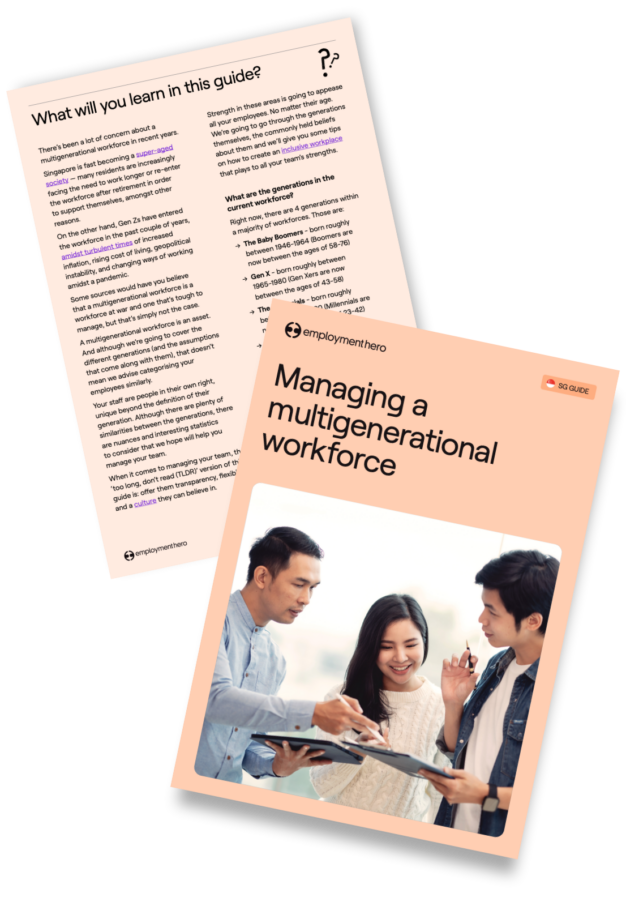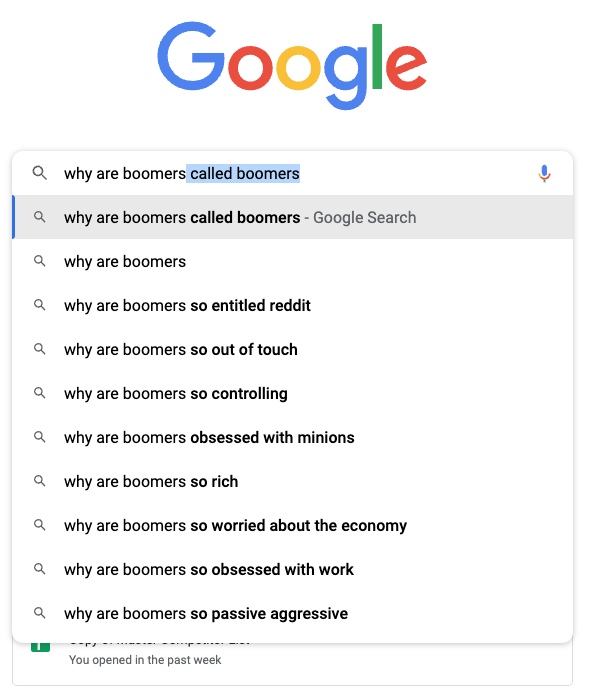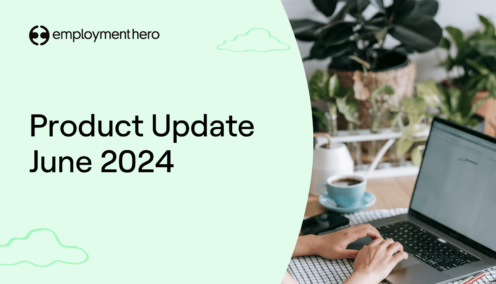Some sources would have you believe that a multigenerational workforce is a workforce at war, one that’s tough to manage, but that’s simply not the case.
A multigenerational workforce is an asset. And although we’re going to cover the generations (and the assumptions that come along with them), that doesn’t mean we advise categorising your employees similarly.
Your staff are people in their own right, unique beyond the definition of their generation. While there are plenty of similarities between the generations, there are nuances and interesting statistics to consider that we hope will help you manage your team.

What will you learn in this guide?
When it comes to managing your team, the ‘too long, didn’t read (TLDR)’ version of this article is: offer them transparency, flexibility and a culture they can believe in. Strength in these areas is going to appease all your employees, no matter their age.
This guide is going to cover:
- The current generations in your 2024 workforce
- Why it’s important to think and learn about multigenerational teams
- The most apparent impact the different generations have on the current workforce
- The benefits of working with a multigenerational workforce
- The challenges businesses face with a team of varying ages
- How to promote age diversity in your workforce
- How you can utilise software to better manage your team

What are the generations in the current workforce?
Right now, there are 4 generations within a majority of workforces. Those are:
- The Baby Boomers – born roughly between 1946-1964 (Boomers are now between the ages of 59-77)
- Gen X – born roughly between 1965-1980 (Gen Xers are now between the ages of 44-59)
- The Millennials – born roughly between 1981-2000 (Millennials are now between the ages of 24-43)
- Gen Z – born roughly between 1996-2012 (Gen Zers are now between the ages of 12-28)
While you’re bound to have a mix of age groups in your workforce, you might find your team leaning more towards one generation. If that’s the case, it could be even more important to ensure you’re not alienating any of your team.
Why is it important to learn about managing multigenerational teams?
There is a danger that generational stereotypes become a self-fulfilling prophecy of sorts, especially if the needs of your team are not addressed. A simple Google search will reveal the predetermined thoughts towards certain generations:

It’s important these discriminatory stereotypes don’t come into play within your team. Multigenerational workforce management is all about celebrating the experience and expertise you have across all your people and supporting them equally.
How generational differences are impacting the workplace

To understand workplace impact better, let’s dive into commonly held beliefs and some of the research on this topic.
Baby Boomers in the workplace
Boomers are likely the oldest generation in your workforce. Those who are still working will be inching towards retirement age, or thinking about retirement — some will now have over 50 years of work experience.
This generation is often referred to as “workaholics” because they’re considered hard workers by nature. Highly competitive and valuing workplace visibility, they traditionally prefer office-based work. Fiercely loyal, it’s not uncommon for Boomers to have only had one or two jobs their entire working career.
It’s more challenging to find data on what attracts Boomers to their desired place of work, but we do know that they’re working a lot later in their lives than their parents did.
Generation X in the workplace
Gen X, otherwise deemed the “lost generation” or “latchkey generation” have witnessed some of the world’s greatest technological advancements. They’re also considered to be the first generation to start the conversation around work-life balance (a quality often associated with both Millennials and Gen Z).
According to DDI’s 2018 Global Leadership Forecast, Gen Xers hold over 50% of all leadership roles. And they keep expanding their footprint as managers. They’re deemed naturally autonomous and independent. However, there is also a belief that Gen X are quite cynical.
Zety’s Generation X in the Workplace Study has also found that when looking for an ideal role:
- 28% look for a strong work-life balance
- 26% want an open and honest work environment
- 23% are interested in professional development and collaboration
When asked to compare themselves with Gen Zs, Millennials and Baby Boomers, Gen X respondents believed their generation to simply be the best. They claimed that they had a better work ethic, were more independent, as well as more entrepreneurial than the other generations.
The same study also found that 71% of Gen X respondents wanted their work to be meaningful while 84% wanted job satisfaction from their day to day. This puts to rest the commonly held perception that they work for money and come home to switch off.
Millennials in the workplace
Millennials got a lot of flak in the workplace – until the Gen Zs came along. They are known for being the “everybody wins” generation, narcissistic and self-entitled. However, they’re also considered pragmatic, determined and perhaps a smidge idealistic.
They are early adopters of technology and look for the same adoption in their places of work.
Right now, millennials account for the largest section of the global workforce, with projections using UN data showing that in 2020 they were accountable for 41% of it. They look to be the largest section of the workforce into the future, with the same data showing they’ll represent 39% in 2025 and 37% in 2030.
A Deloitte study tells us that when millennials are searching for a job:
- 39% look for a good work-life balance offering
- 29% look for learning and development opportunities
- 27% are interested in high salaries and benefits
- 26% want their work to be meaningful
Millenials largest impact on their workplaces have been finding new ways to openly communicate with their teams, emphasising and getting behind company culture and redesigning the way workplaces operate efficiently.
Gen Z in the workplace
Generation Z are the youngest, most diverse and well-educated workers to ever enter the talent pool. However, they are often seen as “too entitled”, “picky” and “unmotivated to work hard”.
Their main drivers are work-life balance, a positive culture and convenience. However, issues can arise with their employers when there are misaligned on expectations around money, job flexibility or support. They’ve ushered in a new era of asking “what can your company offer me?”, rather than offering their skills up to any company.
They’re incredibly entrepreneurial and often opt to start their own business, or freelance in order to have their needs met. Being the most well-educated generation, they’re a savvy bunch looking for investment within a strong culture that promotes self-care, health and wellbeing.
Gen Zs are also sensitive to realities that tend to be swept under the rug—like the issue of unpaid labour. The waves of layoffs from corporations around the world have only served to solidify the impression that, in the workplace, loyalty seldom pays. Gen Zs are learning from this and asking—why should they dedicate their lives for a company that wouldn’t hesitate to let them go in the blink of an eye?
So unlike previous generations, they aren’t feeling as though loyalty to one company is going to take them to their career goals. They’re looking for a future where the world of work is more relaxed, creative and technology-embracing.
What are the benefits of multigenerational teams?
Multigenerational teams bring a diverse range of benefits to the workplace, which drive both individual and organisational success.
We go into a little more detail about these in the guide, but the main benefits are:
- Creativity and innovation
- Talent pipeline
- Different perspectives
- Knowledge sharing
- Adaptability to change
- Improved communication skills
- Insights into different market segments
What are some common challenges of managing a multigenerational workforce?

Ageism alongside different working and communication styles are the most common issues you’ll encounter when working with a multigenerational team. In our guide, we point you towards the correct handling of difficult conversations and communications charters.
How can you promote generational diversity in the workplace?
Breaking down barriers and misconceptions is the best way to promote generational diversity in your workplace. Try to utilise teams with varying team members and age groups, or incentivise socials where generations mix.
Outside of promoting being one team and taking advantage of the different levels of experience your team have, in our guide, we point you to the following:
- Leveraging the strengths of different generations
- Addressing conflict and generational stereotypes in the workplace
- Don’t forget to hire older workers
How can HR software help you manage multigenerational teams?
Employee engagement & surveys
Employee engagement software can be a great tool when it comes to managing a multigenerational team. You can send out anonymous surveys to see how your staff are feeling, but also collect specific feedback around how they engage with their peers, management and beyond.
Getting a real insight into your workforce allows you to make the right interventions where needed, and reward and recognise great collaboration.
1:1s
You can create and manage 1:1s with your staff, sending them questions ahead of time to make sure that you make the most of your time together. Having software also holds you accountable for booking time with your staff, getting genuine feedback and working towards goals, which takes us to our next point.
Objectives & key results (OKRs)
Every generation we’ve covered in this piece has a form of intrinsic motivation. Whether they’re deemed competitive, entrepreneurial or just want work that has real impact, setting up and monitoring their OKRs showcases their capability, and the impact they’re having on key business objectives.
Shoutouts
No matter what age group your team falls into, recognition and praise across the team are essential in building a strong work culture. Keep all of your team praise in a central location, and broadcast across all of your people – so whether you’re a hybrid team, or fully remote, your team can achieve together.




